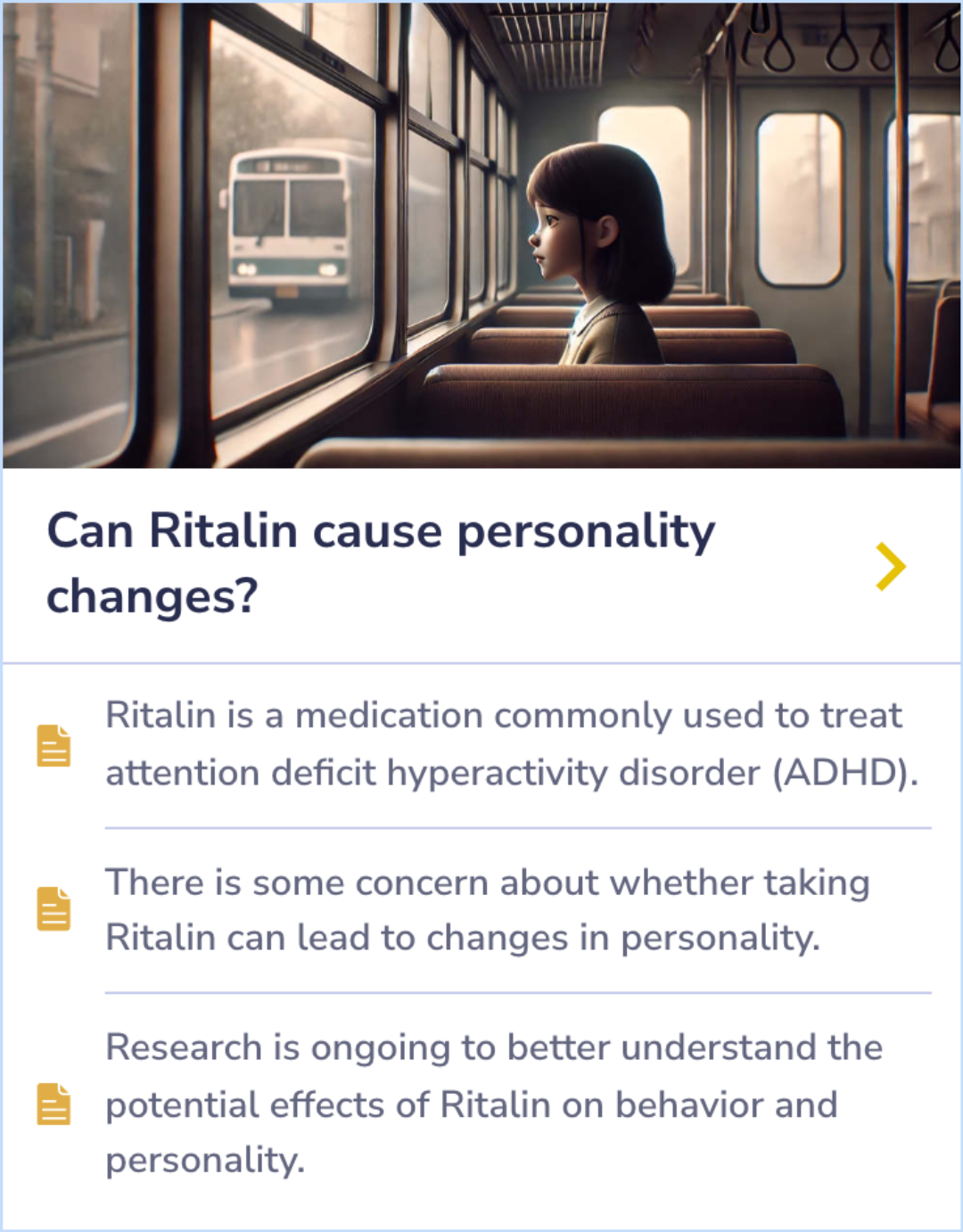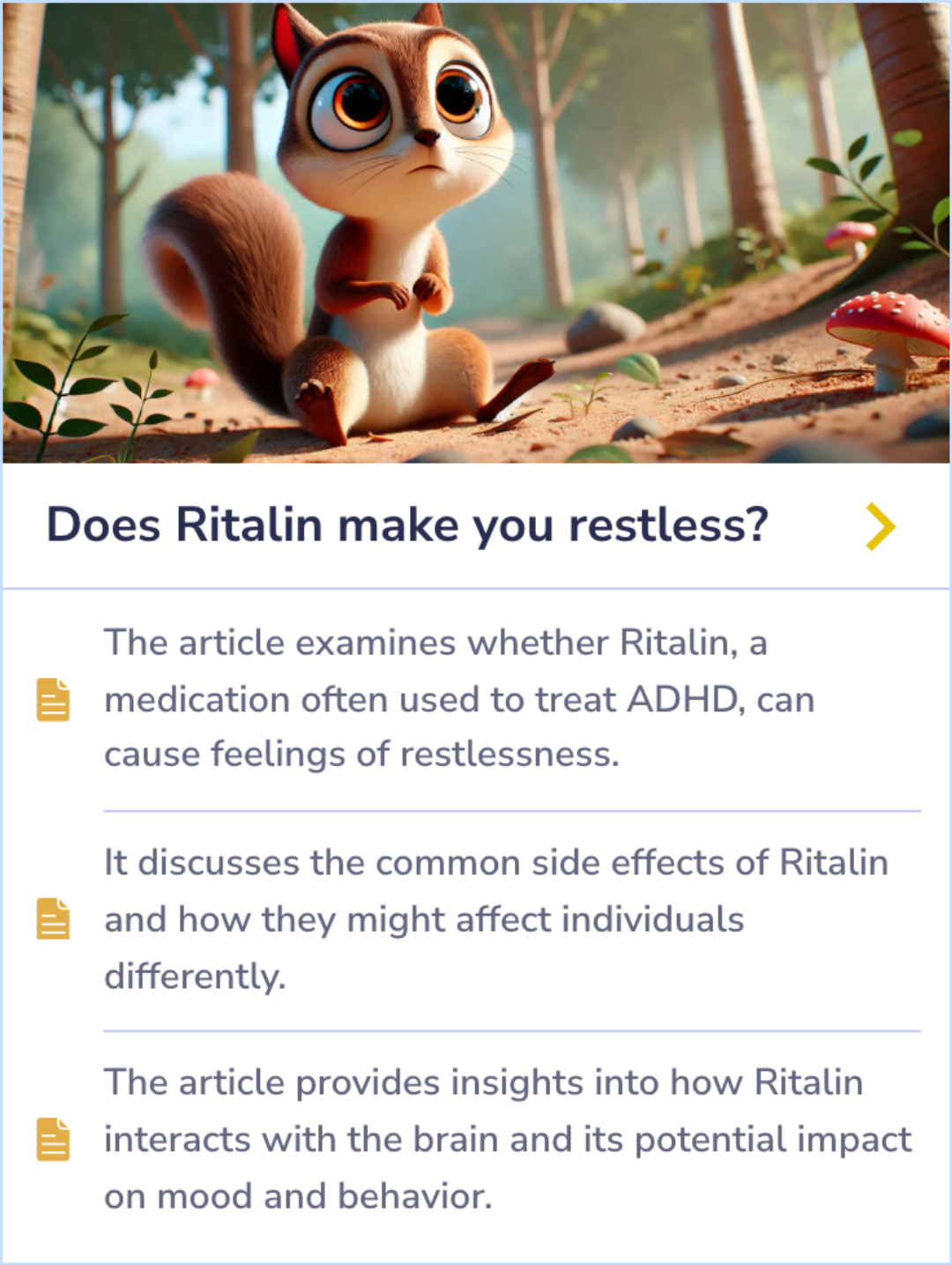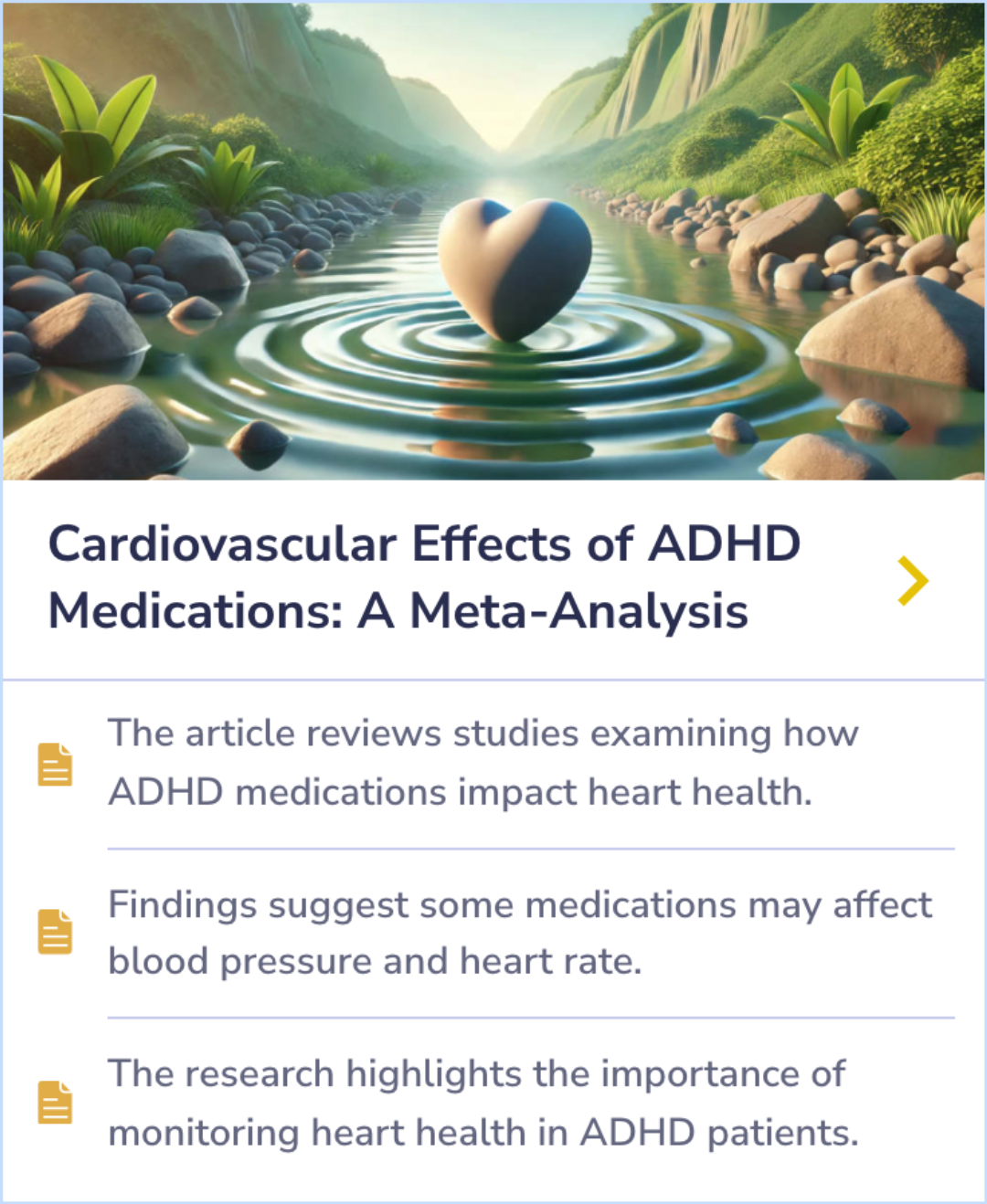Ritalin
Evidence Based Answers
Can Ritalin cause numbness?
Ritalin can impact circulation, potentially causing numbness and other symptoms in fingers and toes, influenced by blood flow changes due to methylphenidate. Awareness of Raynaud's risk and early symptom recognition is helpful.
Click to explore a section:
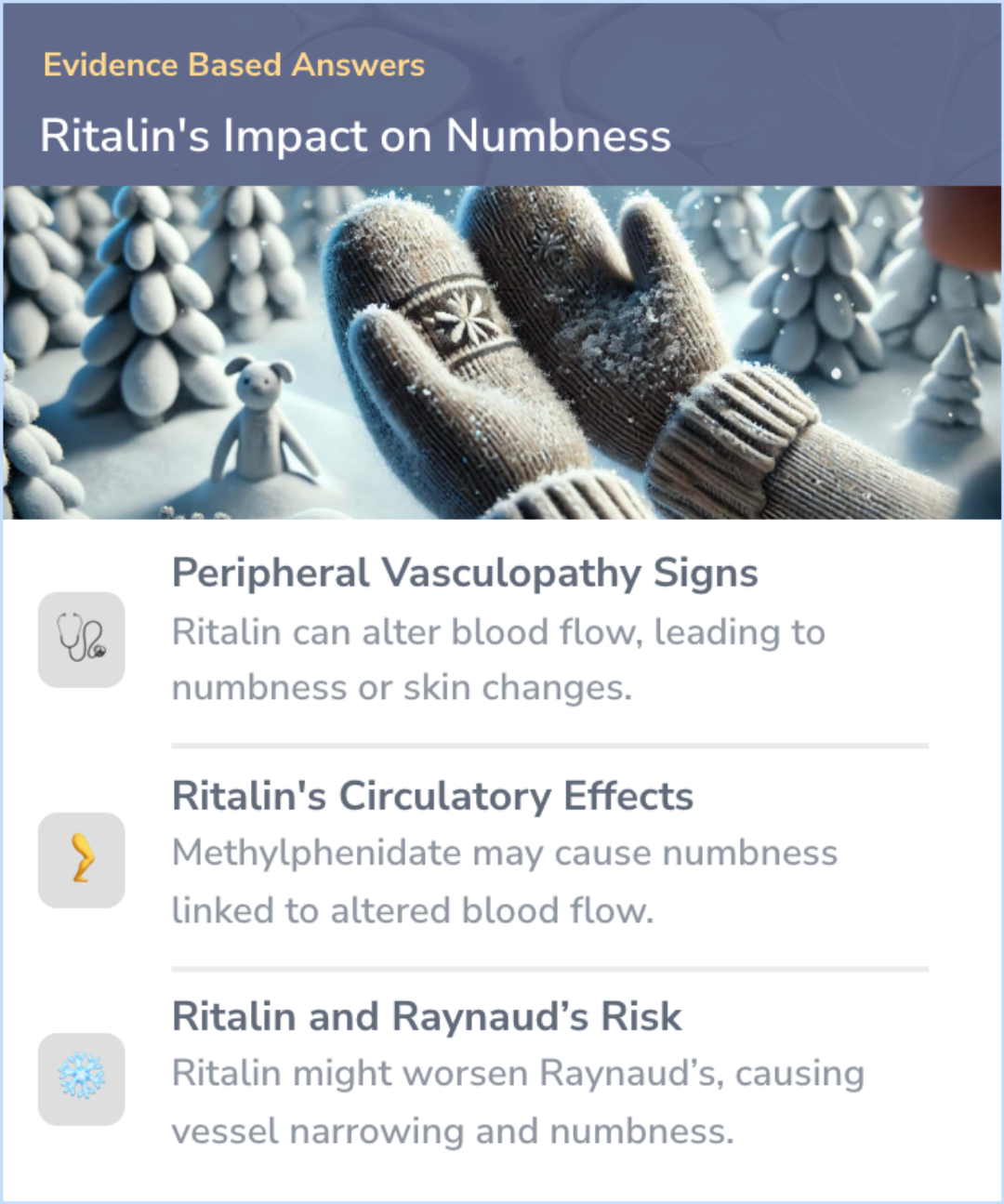
Ritalin can affect circulation, causing numbness due to methylphenidate, with a risk of worsening Raynaud's symptoms.
Peripheral Vasculopathy and Ritalin: Key Symptoms to Watch
Peripheral vasculopathy is a condition that can occur with stimulant medications like Ritalin, affecting blood flow to the fingers and toes. Symptoms may include numbness, coolness, pain, and skin color changes, such as turning pale, blue, or red.
Ritalin's impact on blood circulation may lead to symptoms like numbness or changes in skin temperature, which could signal more serious circulation issues.
Ritalin's impact on blood circulation may lead to symptoms like numbness or changes in skin temperature, which could signal more serious circulation issues.
“
Source Quotes:
Instruct patients beginning treatment with Ritalin or Ritalin-SR about the risk of peripheral vasculopathy, including Raynaud’s Phenomenon, and in associated signs and symptoms: fingers or toes may feel numb, cool, painful, and/or may change color from pale, to blue, to red.
Instruct patients beginning treatment with CONCERTA about the risk of peripheral vasculopathy, including Raynaud’s phenomenon, and associated signs and symptoms: fingers or toes may feel numb, cool, painful, and/or may change color from pale, to blue, to red.
Numbness and Circulatory Symptoms with Ritalin
Methylphenidate, found in Ritalin, can sometimes lead to symptoms like numbness, pain, or sensitivity to temperature in the hands and feet. These may reflect changes in blood flow or nerve function.
Not all users experience these effects, but recognizing any signs early and communicating with a healthcare provider can be important.
Not all users experience these effects, but recognizing any signs early and communicating with a healthcare provider can be important.
“
Source Quotes:
Instruct patients to report to their physician any new numbness, pain, skin color change, or sensitivity to temperature in fingers or toes.
Tell your doctor if you have or your child has numbness, pain, skin color change, or sensitivity to temperature in your fingers or toes.
Ritalin and Raynaud’s Phenomenon
Raynaud’s phenomenon involves a narrowing of blood vessels in the fingers and toes, triggered by cold or stress, causing numbness, discoloration, and coolness. Stimulants like Ritalin may increase the risk due to their effect on circulation.
Being aware of this condition helps users recognize symptoms early and consult with a healthcare professional if necessary.
Being aware of this condition helps users recognize symptoms early and consult with a healthcare professional if necessary.
“
Source Quotes:
Instruct patients beginning treatment with Ritalin or Ritalin-SR about the risk of peripheral vasculopathy, including Raynaud’s Phenomenon, and in associated signs and symptoms: fingers or toes may feel numb, cool, painful, and/or may change color from pale, to blue, to red.
Instruct patients beginning treatment with CONCERTA about the risk of peripheral vasculopathy, including Raynaud’s phenomenon, and associated signs and symptoms: fingers or toes may feel numb, cool, painful, and/or may change color from pale, to blue, to red.
Key Takeaways
Conclusions
Ritalin, a commonly used stimulant medication, has been associated with peripheral vasculopathy—a condition disrupting blood flow to extremities like fingers and toes. This can lead to symptoms such as numbness, coolness, and skin discoloration, indicating potential circulation issues.
Studies show that Ritalin can also trigger symptoms reminiscent of Raynaud’s phenomenon, including numbness and color changes due to narrowed blood vessels. While not all users face these issues, monitoring symptoms and communicating with healthcare providers can be crucial for managing potential side effects effectively.
Studies show that Ritalin can also trigger symptoms reminiscent of Raynaud’s phenomenon, including numbness and color changes due to narrowed blood vessels. While not all users face these issues, monitoring symptoms and communicating with healthcare providers can be crucial for managing potential side effects effectively.
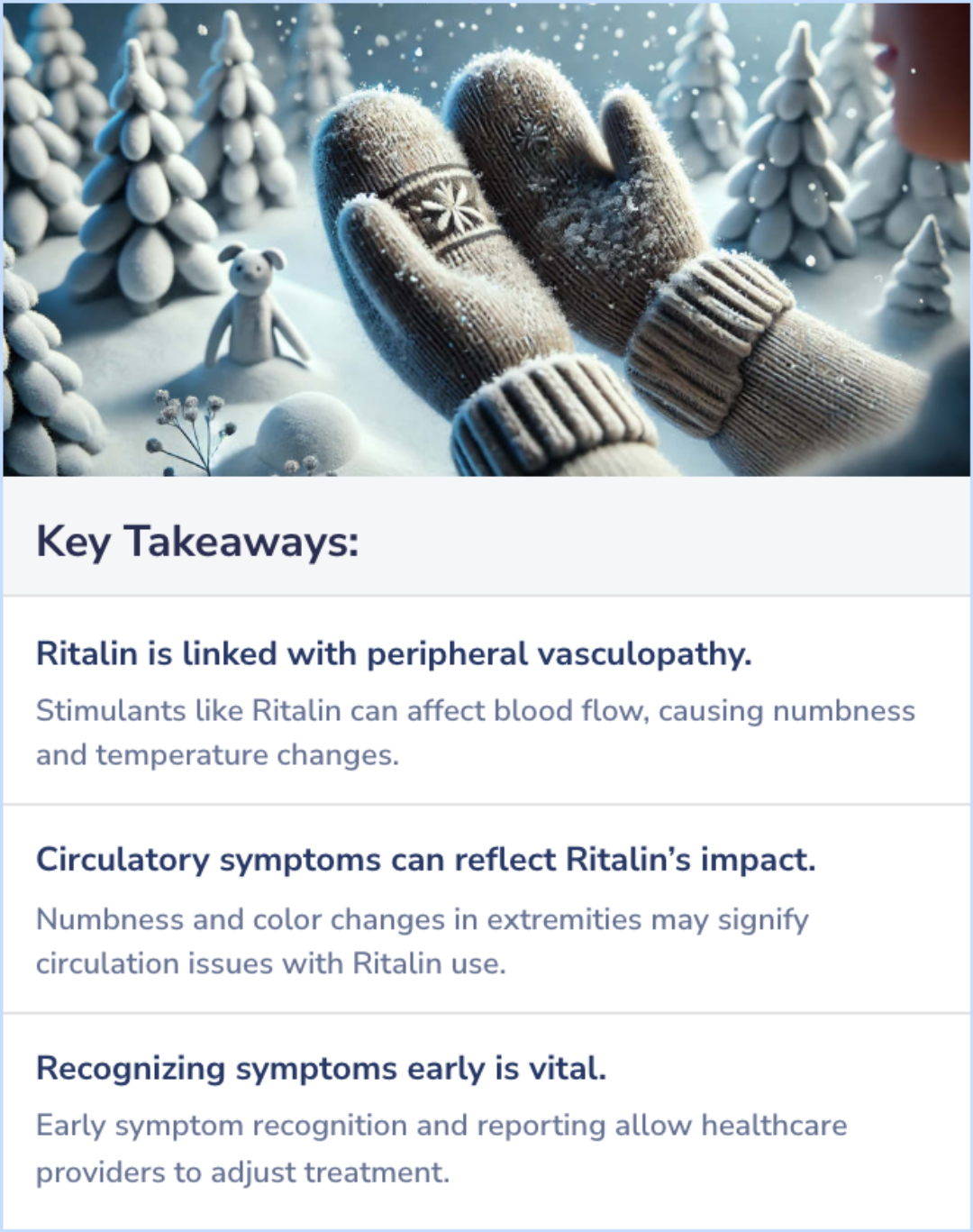
Evidence Summary
Does Ritalin Influence Personality?
Ritalin, commonly prescribed for ADHD, has been studied for its effects beyond symptom management. Researchers are examining whether it alters aspects of personality or behavior, which raises questions about how it may influence daily interactions and self-perception. While it helps reduce inattention and impulsivity, studies are ongoing to determine if and to what extent it shifts personality traits.
Concerns focus on potential behavioral changes while taking Ritalin, underscoring a need to monitor any noticeable shifts during treatment. Research seeks clarity on how this medication might affect personality in different users.
Concerns focus on potential behavioral changes while taking Ritalin, underscoring a need to monitor any noticeable shifts during treatment. Research seeks clarity on how this medication might affect personality in different users.
Evidence Summary
Ritalin and Its Effects on Restlessness and Mood
Ritalin, often prescribed for ADHD, can sometimes cause restlessness as a side effect. The drug’s influence varies, with some users experiencing mood shifts and behavioral changes. These differences highlight how Ritalin interacts with the brain in unique ways for each person.
Side effects can range widely, and understanding how these manifest offers a glimpse into how medications like Ritalin shape day-to-day experiences and mood stability for users.
Side effects can range widely, and understanding how these manifest offers a glimpse into how medications like Ritalin shape day-to-day experiences and mood stability for users.
Evidence Summary
Unexpected Tiredness from Ritalin
Ritalin is prescribed to improve focus and attention in individuals with ADHD. Despite being a stimulant, it can lead to unexpected tiredness in some users, a side effect that may seem contradictory to its intended purpose.
While enhancing focus, certain individuals experience fatigue, highlighting the diverse responses to the medication. Exploring this helps patients and healthcare providers navigate daily challenges more effectively.
While enhancing focus, certain individuals experience fatigue, highlighting the diverse responses to the medication. Exploring this helps patients and healthcare providers navigate daily challenges more effectively.
Evidence Summary
How ADHD Medications Affect Heart Health
ADHD medications can impact heart health, with research showing changes in blood pressure and heart rate in some cases. These medications may elevate or lower these measures, depending on factors like dosage and individual response.
Research emphasizes the need for regular cardiovascular monitoring in ADHD patients, as these adjustments can help manage any potential risks tied to medication use.
Research emphasizes the need for regular cardiovascular monitoring in ADHD patients, as these adjustments can help manage any potential risks tied to medication use.
